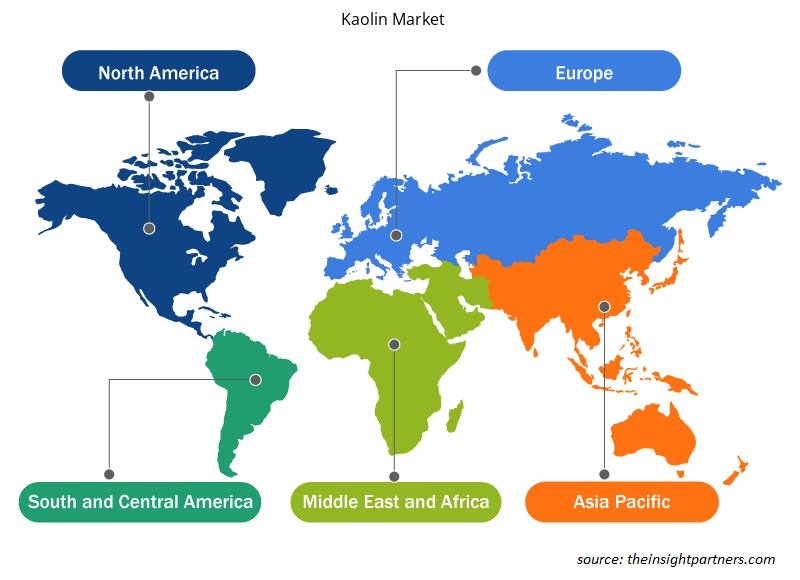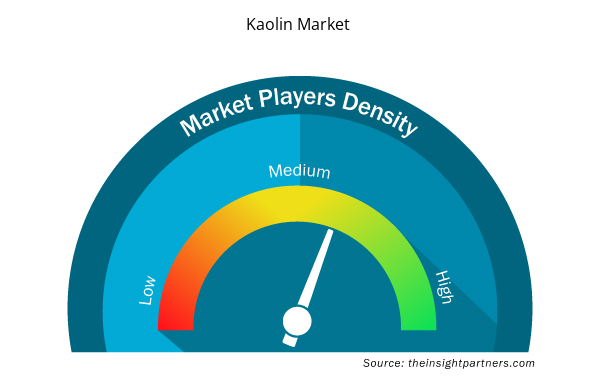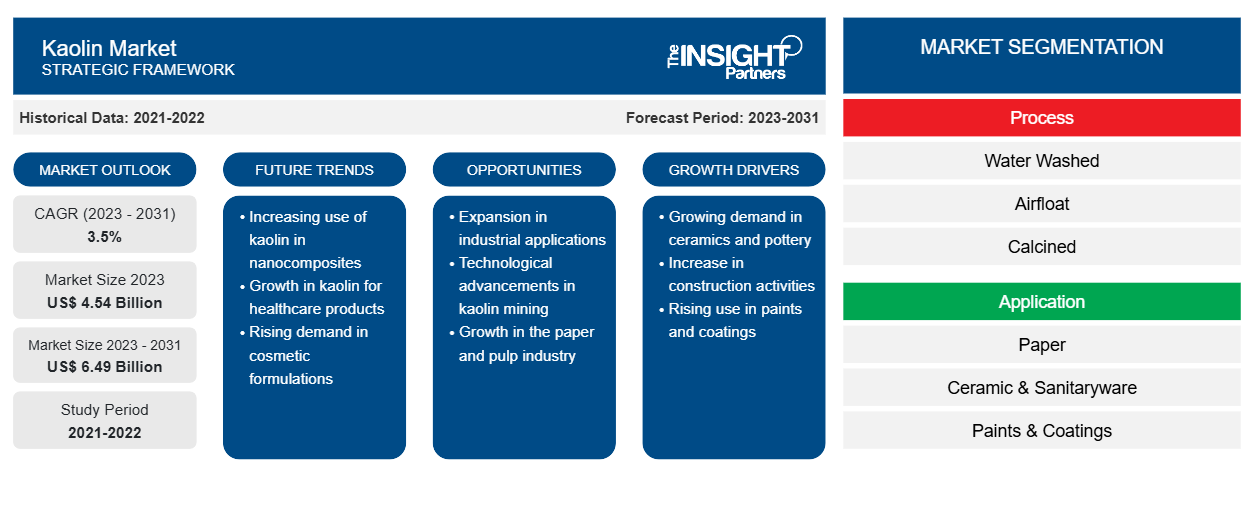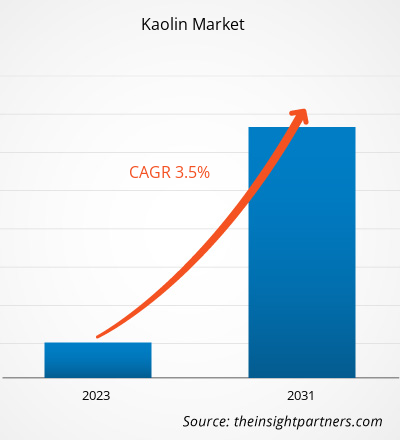Se proyecta que el tamaño del mercado del caolín alcance los 6.490 millones de dólares en 2031, frente a los 4.540 millones de dólares en 2023. Se espera que el mercado registre una CAGR del 3,5 % durante el período 2023-2031. Es probable que la creciente demanda de las industrias de uso final, incluidos los envases de papel, el plástico, el caucho, las pinturas y los revestimientos y los artículos sanitarios, siga siendo una tendencia clave en los mercados del caolín.CAGR of 3.5% during 2023–2031. The growing demand from end-use industries, including paper packaging, plastic, rubber, paints and coatings, and sanitaryware, is likely to remain a key trend in the kaolin markets.
Análisis del mercado del caolín
La creciente demanda de automóviles a nivel mundial está favoreciendo el crecimiento del mercado del caolín. La industria automotriz es uno de los principales beneficiarios de los productos de caolín, ya que la industria utiliza ampliamente componentes y piezas fabricados con caucho. El caolín mejora las propiedades químico-físicas y el rendimiento de los componentes automotrices de caucho. El caolín se usa ampliamente en neumáticos de automóviles para proporcionar rigidez y reforzar el caucho, aportando resistencia al desgarro y propiedades de resistencia a la tracción a los neumáticos. Además, ayuda a mejorar la permeabilidad al aire y la barrera de gas de los revestimientos internos de los neumáticos, lo que extiende la vida útil de los neumáticos. Además, el caolín encuentra una amplia aplicación en los sellos de la carrocería de los automóviles debido a la conductividad eléctrica reducida, protegiendo contra las propiedades de corrosión. Además, el caolín se utiliza para fabricar componentes automotrices como juntas tóricas de fluoroelastómero para sellos de inyectores de combustible, juntas y mangueras. Además, el caolín encuentra aplicación en la fabricación de pinturas y recubrimientos a base de agua, que se utilizan ampliamente en la industria automotriz para pintar y recubrir piezas y superficies de automóviles.
Descripción general del mercado del caolín
Existen distintos tipos de caolín. Entre los más destacados se encuentran el caolín lavado con agua, el caolín calcinado, el caolín deslaminado y el caolín de flotación por aire. El caolín se utiliza ampliamente como relleno en las industrias médica, de pinturas y revestimientos, papel, caucho y otras industrias de uso final. Además, el aumento de la producción de papel y su uso en los sectores comercial y educativo contribuye al crecimiento del mercado del caolín.
Personalice este informe según sus necesidades
Obtendrá personalización en cualquier informe, sin cargo, incluidas partes de este informe o análisis a nivel de país, paquete de datos de Excel, así como también grandes ofertas y descuentos para empresas emergentes y universidades.
- Obtenga las principales tendencias clave del mercado de este informe.Esta muestra GRATUITA incluirá análisis de datos, desde tendencias del mercado hasta estimaciones y pronósticos.
Factores impulsores y oportunidades del mercado del caolín
La creciente demanda de productos cosméticos y de cuidado personal a nivel mundial impulsa el crecimiento del mercado del caolín
Los productos de belleza y cuidado de la piel están siendo testigos de un aumento en el uso del caolín. El caolín se usa ampliamente en productos de belleza como polvos faciales, mascarillas faciales, cremas y lociones para pieles grasas, polvos de baño, bases de maquillaje, rubores en polvo, desodorantes y jabones. Estos productos utilizan caolín para absorber el exceso de grasa de la superficie de la piel, levantando la suciedad y otras impurezas de los poros de la piel. Además, el caolín tiene propiedades de control de la grasa, lo que permite que el maquillaje dure más tiempo, resistiendo la transpiración en condiciones húmedas o mojadas. Además, la creciente demanda de productos cosméticos a nivel mundial está aumentando la necesidad de caolín. Por lo tanto, la creciente demanda de cosméticos y productos de cuidado personal está impulsando el crecimiento del mercado del caolín.
La creciente urbanización en las economías en desarrollo
Se espera que la rápida urbanización en países en desarrollo como China, India, Brasil y Vietnam impulse el crecimiento del mercado del caolín. Estos países están siendo testigos de un aumento en la construcción de edificios residenciales y comerciales, lo que se espera que aumente la demanda de caolín en las economías en desarrollo. Además, el caolín se utiliza ampliamente en la industria cerámica por sus propiedades de moldeo. También se utiliza en la fabricación de artículos sanitarios, azulejos y vajillas y se ha utilizado significativamente como sustituto directo del método tradicional del cemento. Además, la arcilla de caolín se utiliza como extensor funcional en pinturas. Esto se debe a que la arcilla de caolín es químicamente inerte, tiene un alto poder cubriente, proporciona propiedades de flujo deseables y reduce la cantidad de pigmentos costosos necesarios. Se espera que estos factores impulsen el crecimiento del mercado del caolín.
Análisis de segmentación del informe de mercado de caolín
Los segmentos clave que contribuyeron a la derivación del análisis del mercado de caolín son el proceso y la aplicación.
- Según el proceso, el mercado se segmenta en lavado con agua, flotación por aire, calcinado, deslaminado y otros. El segmento lavado con agua tuvo la mayor participación de mercado en 2023.
- En términos de aplicación, el mercado está segmentado en papel, cerámica y sanitarios, pinturas y revestimientos, plástico, caucho y otros. El segmento del papel tuvo la mayor participación del mercado en 2023.
Análisis de la cuota de mercado del caolín por geografía
El alcance geográfico del informe del mercado de caolín se divide principalmente en cinco regiones: América del Norte, Asia Pacífico, Europa, Medio Oriente y África, y América del Sur y Central.
Muchos de los países de Asia Pacífico, como China e India, se encuentran entre las poblaciones de más rápido crecimiento del mundo. Con una población en aumento, las industrias automotriz, de embalaje y de la construcción tienen una gran demanda en Asia Pacífico. La industria de la impresión de envases se está expandiendo en Asia Pacífico debido a su amplia gama de aplicaciones. La existencia de sectores establecidos como alimentos y bebidas, electrónica de consumo y muchos otros en naciones como China, India, Japón y Corea del Sur ha aumentado la demanda de soluciones de embalaje en la región. El mercado de embalajes de papel en Asia Pacífico ha sido testigo de un crecimiento notable, debido a la rápida expansión de la industria del embalaje, el creciente sector minorista de alimentos y la creciente conciencia de los consumidores sobre las soluciones de embalaje sostenibles en toda la región. El sector de servicios de alimentos en Asia Pacífico se está expandiendo rápidamente, debido al rápido crecimiento económico, el crecimiento del sector turístico, la mejora de los estilos de vida de los consumidores y un aumento en los niveles de ingresos disponibles.
Perspectivas regionales del mercado del caolín
Los analistas de Insight Partners explicaron en detalle las tendencias y los factores regionales que influyen en el mercado del caolín durante el período de pronóstico. Esta sección también analiza los segmentos y la geografía del mercado del caolín en América del Norte, Europa, Asia Pacífico, Oriente Medio y África, y América del Sur y Central.

- Obtenga los datos regionales específicos para el mercado de caolín
Alcance del informe sobre el mercado del caolín
| Atributo del informe | Detalles |
|---|---|
| Tamaño del mercado en 2023 | US$ 4,54 mil millones |
| Tamaño del mercado en 2031 | 6.490 millones de dólares estadounidenses |
| CAGR global (2023 - 2031) | 3,5% |
| Datos históricos | 2021-2022 |
| Período de pronóstico | 2023-2031 |
| Segmentos cubiertos | Por proceso
|
| Regiones y países cubiertos | América del norte
|
| Líderes del mercado y perfiles de empresas clave |
|
Densidad de actores del mercado del caolín: comprensión de su impacto en la dinámica empresarial
El mercado del caolín está creciendo rápidamente, impulsado por la creciente demanda de los usuarios finales debido a factores como la evolución de las preferencias de los consumidores, los avances tecnológicos y una mayor conciencia de los beneficios del producto. A medida que aumenta la demanda, las empresas amplían sus ofertas, innovan para satisfacer las necesidades de los consumidores y aprovechan las tendencias emergentes, lo que impulsa aún más el crecimiento del mercado.
La densidad de actores del mercado se refiere a la distribución de las empresas o firmas que operan dentro de un mercado o industria en particular. Indica cuántos competidores (actores del mercado) están presentes en un espacio de mercado determinado en relación con su tamaño o valor total de mercado.
Las principales empresas que operan en el mercado del caolín son:
- Elementos americanos
- Esán
- Compañía de pigmentos Burgess
- Imerys SA
- Sibelco
- Compañía de caolín Thiele
Descargo de responsabilidad : Las empresas enumeradas anteriormente no están clasificadas en ningún orden particular.

- Obtenga una descripción general de los principales actores clave del mercado de caolín
Noticias y desarrollos recientes del mercado del caolín
El mercado del caolín se evalúa mediante la recopilación de datos cualitativos y cuantitativos posteriores a la investigación primaria y secundaria, que incluye publicaciones corporativas importantes, datos de asociaciones y bases de datos. A continuación, se incluye una lista de los avances en el mercado del caolín:
- BASF cerró la venta de su negocio de minerales de caolín a KaMin, una empresa global de minerales de alto rendimiento con sede en Macon, Georgia, Estados Unidos, tras el cumplimiento de las condiciones de autorización. (Fuente: BASF SE, comunicado de prensa, 2022)
Informe sobre el mercado del caolín: cobertura y resultados
El informe "Tamaño y pronóstico del mercado de caolín (2021-2031)" proporciona un análisis detallado del mercado que cubre las siguientes áreas:
- Tamaño del mercado y pronóstico a nivel global, regional y nacional para todos los segmentos clave del mercado cubiertos bajo el alcance
- Dinámica del mercado, como impulsores, restricciones y oportunidades clave
- Principales tendencias futuras
- Análisis detallado de las cinco fuerzas de Porter y FODA
- Análisis del mercado global y regional que cubre las tendencias clave del mercado, los principales actores, las regulaciones y los desarrollos recientes del mercado.
- Análisis del panorama de la industria y de la competencia que abarca la concentración del mercado, el análisis de mapas de calor, los actores destacados y los desarrollos recientes
- Perfiles detallados de empresas
- Análisis histórico (2 años), año base, pronóstico (7 años) con CAGR
- Análisis PEST y FODA
- Tamaño del mercado Valor/volumen: global, regional, nacional
- Industria y panorama competitivo
- Conjunto de datos de Excel



Report Coverage
Revenue forecast, Company Analysis, Industry landscape, Growth factors, and Trends

Segment Covered
This text is related
to segments covered.

Regional Scope
North America, Europe, Asia Pacific, Middle East & Africa, South & Central America

Country Scope
This text is related
to country scope.
Trends and growth analysis reports related to Chemicals and Materials : READ MORE..
The Insight Partners performs research in 4 major stages: Data Collection & Secondary Research, Primary Research, Data Analysis and Data Triangulation & Final Review.
- Data Collection and Secondary Research:
As a market research and consulting firm operating from a decade, we have published and advised several client across the globe. First step for any study will start with an assessment of currently available data and insights from existing reports. Further, historical and current market information is collected from Investor Presentations, Annual Reports, SEC Filings, etc., and other information related to company’s performance and market positioning are gathered from Paid Databases (Factiva, Hoovers, and Reuters) and various other publications available in public domain.
Several associations trade associates, technical forums, institutes, societies and organization are accessed to gain technical as well as market related insights through their publications such as research papers, blogs and press releases related to the studies are referred to get cues about the market. Further, white papers, journals, magazines, and other news articles published in last 3 years are scrutinized and analyzed to understand the current market trends.
- Primary Research:
The primarily interview analysis comprise of data obtained from industry participants interview and answers to survey questions gathered by in-house primary team.
For primary research, interviews are conducted with industry experts/CEOs/Marketing Managers/VPs/Subject Matter Experts from both demand and supply side to get a 360-degree view of the market. The primary team conducts several interviews based on the complexity of the markets to understand the various market trends and dynamics which makes research more credible and precise.
A typical research interview fulfils the following functions:
- Provides first-hand information on the market size, market trends, growth trends, competitive landscape, and outlook
- Validates and strengthens in-house secondary research findings
- Develops the analysis team’s expertise and market understanding
Primary research involves email interactions and telephone interviews for each market, category, segment, and sub-segment across geographies. The participants who typically take part in such a process include, but are not limited to:
- Industry participants: VPs, business development managers, market intelligence managers and national sales managers
- Outside experts: Valuation experts, research analysts and key opinion leaders specializing in the electronics and semiconductor industry.
Below is the breakup of our primary respondents by company, designation, and region:

Once we receive the confirmation from primary research sources or primary respondents, we finalize the base year market estimation and forecast the data as per the macroeconomic and microeconomic factors assessed during data collection.
- Data Analysis:
Once data is validated through both secondary as well as primary respondents, we finalize the market estimations by hypothesis formulation and factor analysis at regional and country level.
- Macro-Economic Factor Analysis:
We analyse macroeconomic indicators such the gross domestic product (GDP), increase in the demand for goods and services across industries, technological advancement, regional economic growth, governmental policies, the influence of COVID-19, PEST analysis, and other aspects. This analysis aids in setting benchmarks for various nations/regions and approximating market splits. Additionally, the general trend of the aforementioned components aid in determining the market's development possibilities.
- Country Level Data:
Various factors that are especially aligned to the country are taken into account to determine the market size for a certain area and country, including the presence of vendors, such as headquarters and offices, the country's GDP, demand patterns, and industry growth. To comprehend the market dynamics for the nation, a number of growth variables, inhibitors, application areas, and current market trends are researched. The aforementioned elements aid in determining the country's overall market's growth potential.
- Company Profile:
The “Table of Contents” is formulated by listing and analyzing more than 25 - 30 companies operating in the market ecosystem across geographies. However, we profile only 10 companies as a standard practice in our syndicate reports. These 10 companies comprise leading, emerging, and regional players. Nonetheless, our analysis is not restricted to the 10 listed companies, we also analyze other companies present in the market to develop a holistic view and understand the prevailing trends. The “Company Profiles” section in the report covers key facts, business description, products & services, financial information, SWOT analysis, and key developments. The financial information presented is extracted from the annual reports and official documents of the publicly listed companies. Upon collecting the information for the sections of respective companies, we verify them via various primary sources and then compile the data in respective company profiles. The company level information helps us in deriving the base number as well as in forecasting the market size.
- Developing Base Number:
Aggregation of sales statistics (2020-2022) and macro-economic factor, and other secondary and primary research insights are utilized to arrive at base number and related market shares for 2022. The data gaps are identified in this step and relevant market data is analyzed, collected from paid primary interviews or databases. On finalizing the base year market size, forecasts are developed on the basis of macro-economic, industry and market growth factors and company level analysis.
- Data Triangulation and Final Review:
The market findings and base year market size calculations are validated from supply as well as demand side. Demand side validations are based on macro-economic factor analysis and benchmarks for respective regions and countries. In case of supply side validations, revenues of major companies are estimated (in case not available) based on industry benchmark, approximate number of employees, product portfolio, and primary interviews revenues are gathered. Further revenue from target product/service segment is assessed to avoid overshooting of market statistics. In case of heavy deviations between supply and demand side values, all thes steps are repeated to achieve synchronization.
We follow an iterative model, wherein we share our research findings with Subject Matter Experts (SME’s) and Key Opinion Leaders (KOLs) until consensus view of the market is not formulated – this model negates any drastic deviation in the opinions of experts. Only validated and universally acceptable research findings are quoted in our reports.
We have important check points that we use to validate our research findings – which we call – data triangulation, where we validate the information, we generate from secondary sources with primary interviews and then we re-validate with our internal data bases and Subject matter experts. This comprehensive model enables us to deliver high quality, reliable data in shortest possible time.


 Obtenga una muestra gratuita de este informe
Obtenga una muestra gratuita de este informe